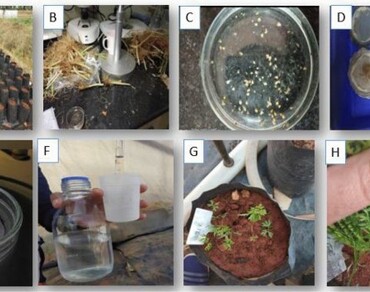Genetic analysis of root-knot nematode (Meloidogyne incognita) resistance in carrot (Daucus carota L.)
Manisha Manisha, Padmini K., Dhananjaya M. V., UmaMaheswari R., Reddy D. C. Lakshmana, Rao V. Keshav
Research Articles | Published: 13 June, 2024
First Page: 978
Last Page: 984
Views: 1936
Keywords: Additive, Carrot, Chi-square, Non-significance, Single recessive gene
Abstract
The genetics analysis for a specific characteristic is critical to monitor plant health along with developing and testing novel, cost-effective, and long-term management. Root knot nematode by formation of galls causes a significant yield lossess in tropical carrots. Severe infestations result in forking or fanging of the roots, reducing their marketability. In carrot production, genetic resistance considerably reduce the requirement for broad-spectrum soil fumigants. The genetics and nature of root-knot nematode resistance in carrot were identified using root gall index in the plastic bag settings using a pure culture of root-knot nematode. In order to carry out this research, we used one immune parent (Acc-88) and one highly susceptible parent (Acc-113B) to produce F1, F2, BC1P1 and BC1P2 progenies. In cross between Acc-113B x Acc-88, chi-square analysis indicated that root-knot nematode (Meloidogyne incognita) resistance is controlled by a recessive gene. Further, the non-significant scaling test in the cross confirmed the absence of epistatic interaction in this study. By evaluating three parameters [m, d, and h] through generation mean analysis, the results suggested that cross had a predominance of additive types. All of the above results showed that it might be possible to improve resistance to root-knot nematodes by backcross breeding.

References
Alasalvar C, Grigor JM, Zhang D, Quantick PC, Shahidi F (2001) Comparison of volatiles, phenolics, sugars, antioxidant vitamins, and sensory quality of different colored carrot varieties. J Agric Food Chem 49:1410–1416
Barik S, Ponnam N, Acharya GC, Singh TH, Kumari M, Gouri Shankar S (2021) Genetic analysis of bacterial wilt resistance in eggplant (Solanum melongena L.). Eur J Plant Pathol 160(2):349–364
Block G (1994) Nutrient sources of pro-vitamin acarotenoids in American diets. Am J Epidemiol 139:290–293
Byrd DW Jr, Kirkpatrick T, Barker KR (1983) An improved technique for clearing and staining tissues for detection of nematodes. J Nematol 15:142–143
Coyne DL, Ross JL (2014) Protocol for nematode resistance screening: root knot nematodes, Meloidogyne spp. IITA, Ibadan, p 27
Dias-Arieira CR, De Melo S-G, Puerari HH, Ribeiro LM, Mattei D (2013) Induced resistance in the nematodes control. Afr J Agric Res 8(20):2312–2318
Hayman BI, Mather K (1955) The description of genetic interaction in continuous variation. Biometrics 11:69–82
Huet G (2014) Breeding for resistances to Ralstonia solanacearum. Front Plant Sci 5:715
Jinks JL, Jones RM (1958) Estimation of components of heterosis. Genetics 43:223–234
Kearsey MJ, Pooni HS (1996) The genetical analysis of quantitative traits, 1st edn. Chapman and Hall, London, p 46
Mai W, Abawi GS (1987) Interactions among root knot nematodes and fusarium wilt fungi on host plants. Annu Rev Phytopathol 25(1):317–338
Mather K, Jinks JL (1971) Biometrical genetics, 2nd edn. Chapman and Hall, London
Namisy A, Chen J, Prohen J, Metwally E, Elmahrouk M, Rakha M (2019) Screening of cultivated eggplant and wild relatives for resistance to bacterial wilt (Ralstonia solanacearum). Agriculture 9(7):157
NHB (2020) Indian horticulture database. Gurgaon, New Delhi, National Horticulture Board, Ministry of Agriculture, Government of India
Panse VG, Sukhatme PV (1985) Statistical methods for Agricultural workers, 4th edn. New Delhi, ICAR
Peterson CE, Simon PW (1986) Carrot breeding. In: Basset MJ (ed) Breeding vegetable crops. AVI Publishing Company, Westport (CT), pp 321–356
Robert PA, Mullens TR (2002) Diseases caused by nematodes. In: Davis RM (ed) Compendium of carrot and celery diseases. APS Press, St. Paul (MN), pp 45–50
Sasser, JN and Carter, CC (1982) Overview of the International Meloidogyne project rationale, goals, implementation and progress to date. Proceedings of Conference on Root-Knot nematodes Meloidogyne spp. (Region 111). Brasillia Brazil. 3–13
Simon PW (2000) Domestication, historical development, and modern breeding of carrot. Plant Breed Rev 19:157–190
Seenivasan N (2017) Status of root-knot nematode, Meloidogyne hapla infection on carrot at Kodaikanal Hills of Tamil Nadu, India and its yield loss estimation. Int J Curr Microbiol App Sci 6(9):3629–3635
Selvakumar P, Kalia P, Raje RS (2019) Genetic analysis of nutritional traits in tropical carrot (Daucus carota L.). Genetika 51(2):641–660
Stein M, Nothnagel Th (1995) Some remarks on carrot breeding (Daucus carota sativus Hoffm.). Plant Breed 114:1–11
Subbotin, S. A., Rius, J. E. P. and Castillo, P. (2021) Systematics of root-knot nematodes (Nematoda: Meloidogynidae). Brill.
Taylor AL, Sasser JN, Nelson LA. (1982) Relationship of climate and soil characteristics to geographical distribution of Meloidogyne species in agricultural soils.
Wang M, Goldman IL (1996) Resistance to root-knot nematode (Meloidogyne hapla Chitwood) in carrot is controlled by two recessive genes. J Hered 87(2):119–123
Author Information
Division of Vegetable Crops, ICAR-Indian Institute of Horticultural Research, Bengaluru, India